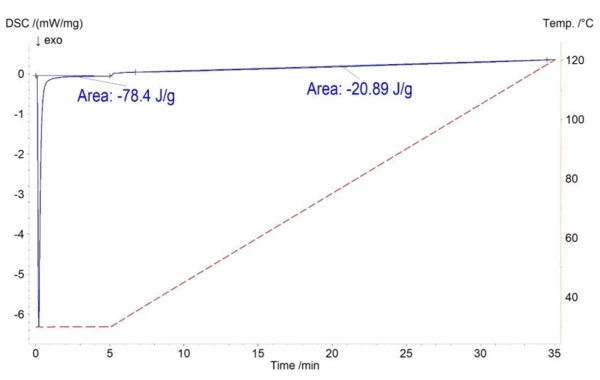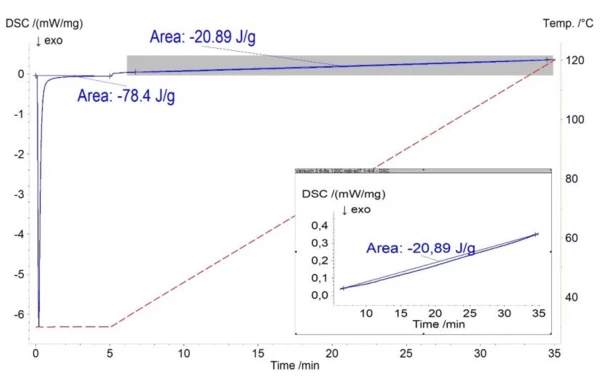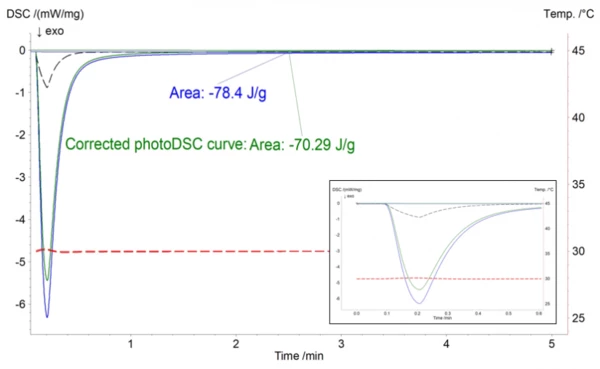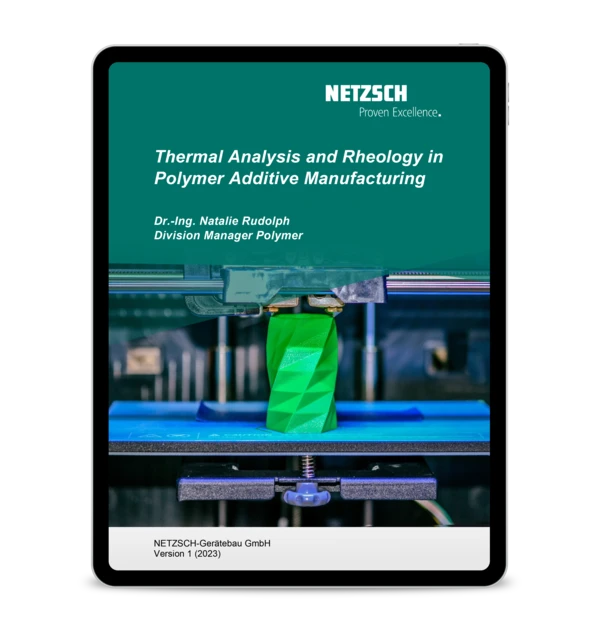
19.04.2021 by Dr. Natalie Rudolph, Dr. Stefan Schmölzer
Investigating UV Exposure and Thermal Cure in Vat Photopolymerization
During the Vat Photopolymerization process, the component is built-up in layers in a liquid resin vat using a UV laser beam to selectively cure the resin. Learn how the degree of thermal cross-linking of a two-component resin is determined by the preceding cross-linking reaction during photo-polymerization.
There are many variations of the process, which are explained in this video.
Configuration of Vat Photopolymerization
One interesting configuration optimized for rapid printing is using mask projection of the whole layer and a top-down movement of the build platform. This means that the UV laser is not tracing the shape of each layer on a pixel basis, but rather the laser beam is shaped into the geometry of the whole layer and exposes it all at once. At the same time, the top-down approach means that the build platform is submerged in the resin and the UV light projection occurs from the bottom through a window. After each layer, the platform is moved up by one layer height and the process is repeated. Curing of a layer between the gap of the window and the build platform or previous layers of the part can lead to adhesion of the part to the window and affect the upward movement. The process principle is explained here.
Therefore, in one variation often referred to as Digital Light Synthesis (DLS), the window is indeed an oxygen permeable membrane. This allows the diffusion of oxygen through the window and into the resin gap. Like all diffusion processes, the concentration change is time-dependent and results in an oxygen saturation right at the interface of the resin and the window and lower concentrations further up in the resin. This effect is used with oxygen sensitive resins, the reaction of which is inhibited by oxygen. One typical example would be acrylates.
Due to this effect, the resin stays liquid at the interface to the window and can be easily released during the upward movement of the platform. The rest of the resin in the gap that is exposed to UV light, however, is being cured. To understand the UV Curing (Crosslinking Reactions)Literally translated, the term “crosslinking“ means “cross networking”. In the chemical context, it is used for reactions in which molecules are linked together by introducing covalent bonds and forming three-dimensional networks.curing behavior of a given resin, Differential Photocalorimetry (given by a Photo-DSC) equipped with a UV light source can be used.
How a Photo-DSC works
In their paper “Investigation of the influence of exposure time on the dual-curing reaction of RPU 70 during the DLS process and the resulting mechanical part properties”, Philip Obstet al. [1] set out to show that the degree of thermal cross-linking of a two-component resin is determined by the preceding cross-linking reaction during photo-polymerization [1].
The study performed in collaboration with NETZSCH Analyzing & Testing uses a Photo-DSC 204 F1 Phoenix® with a OmniCure®S2000 SC UV light extension and analyzes a rigid polyurethane resin.
The resin is a dual cure system that is initially cured by UV light during the 3D printing process. Later on, it is cured at elevated temperatures in a furnace to further improve the mechanical properties and Thermal StabilityA material is thermally stable if it does not decompose under the influence of temperature. One way to determine the thermal stability of a substance is to use a TGA (thermogravimetric analyzer). thermal stability of the component. Both steps can be investigated with the NETZSCH Photo-DSC, where the UV light source can be freely programmed in combination with temperature ramps and IsothermalTests at controlled and constant temperature are called isothermal.isothermal segments. The UV light is emitted by a 200 W mercury short arc lamp contained in the DSC and send via optical fibers and lenses into the measurements chamber onto both the sample and empty pan. A rotary iris mechanism is used to allow precise settings of the exposure times as well as light intensities directly in the NETZSCH Proteus® software. The Omnicure system further offers a wide output spectrum, which can be adapted with band limiting filters if specific wavelengths are needed for an application.
How to measure UV and thermal cure with a NETZSCH Photo-DSC
While the whole study can be found here, one example measurement including the analysis will be presented here.
For the conducted experiments, the complete spectrum of the OmniCure® instrument was used. Due to the constant distance of 20 mm between the light output and the sample, an intensity loss occurs. Therefore, a conversion factor is used to adjust for the loss. To achieve the light intensity of around 9 mW/cm2 that occurs in the 3D printer, a setting of 0.5 W/cm2 was used in the software.
For each measurement, the UV exposure is performed at 30°C during a 5 min IsothermalTests at controlled and constant temperature are called isothermal.isothermal segment. Then, the sample is heated to 120°C using a heating rate of 3 K/min and kept constant for 10 minutes to ensure Curing (Crosslinking Reactions)Literally translated, the term “crosslinking“ means “cross networking”. In the chemical context, it is used for reactions in which molecules are linked together by introducing covalent bonds and forming three-dimensional networks.curing is completed, before it is cooled back down to 30°C.
All measurement conditions are summarized in the following table:
Table 1: Measurement conditions
| Pan | Concavus® Al w/o lid |
| Sample mass | 5 mg |
| Atmosphere | N2 |
| Temperature range | 30°C to 200°C at a heating rate of 3 K/min |
| UV intensity | 0.5 W/cm2 |
| Exposure time | 6.8 s |
In Figure 1, the result of UV cure and subsequent thermal cure is shown. At the beginning of the IsothermalTests at controlled and constant temperature are called isothermal.isothermal segment, the sample is exposed for 6.8 s and the resulting ExothermicA sample transition or a reaction is exothermic if heat is generated.exothermal enthalpy is measured to be 78.4 J/g. During the following heating step, the thermal Curing (Crosslinking Reactions)Literally translated, the term “crosslinking“ means “cross networking”. In the chemical context, it is used for reactions in which molecules are linked together by introducing covalent bonds and forming three-dimensional networks.curing of the sample happens and is already finished when the end temperature of 120°C is reached.

This can be better observed in Figure 2, where the deviation from the baseline is highlighted. It can be seen that the ExothermicA sample transition or a reaction is exothermic if heat is generated.exothermal enthalpy due to the thermal cure is 20.89 J/g.

During UV exposure, the measured energy generated by pure light needs to be corrected for. For that reason, the UV exposure step is repeated on the fully cured resin sample and the enthalpy increase is measured. The result is shown in Figure 3. The blue curve shows the initial measurement (see Figure 1) and the black curve shows the enthalpy of the UV exposure of the fully cured resin. Using the subtraction function in the Proteus® software, the corrected enthalpy is calculated and visualized as the green curve. The ExothermicA sample transition or a reaction is exothermic if heat is generated.exothermal enthalpy after correction is 70.29 J/g.

The right balance matters
This example shows that with an exposure time of 6.8 s, the majority of the curing happens during the UV exposure compared to the thermal cure (21 J/g). It can be seen that the combination of a Photo-DSC and conventional DSC functionality is able to analyze such complex material systems. The complete study shows that lower exposure times shift this ration in the opposite direction: at low exposure duration, the majority of the cross-links is formed during the thermal curing step.
The authors combined these results with mechanical tests on the samples and were able to conclude: the more cure happened due to UV light exposure, the stronger the resulting parts (see Figure 4).

This indicates that the thermal cross-linking depends on the previously formed network during UV exposure. However, the authors also found that if the amount of cross-links from thermal cure gets too low, embrittlement can occur and thus, in turn, the mechanical performance can be reduced as well. The whole study can be read here!
Source and Affiliations
1] Obst, P.a, Riedelbauch, J.a, Oehlmann, P.a, Rietzel, D.a, Launhardt, M.c, Schmölzer, S.d, Osswald, T.A.e and Witt, G.b (2020): Investigation of the influence of exposure time on the dual-curing reaction of RPU 70 during the DLS process and the resulting mechanical part properties. Additive Manufacturing Volume 32. https://doi.org/10.1016/j.addma.2019.101002
aBMW Group, Additive Manufacturing Center, Munich, Germany, bInsititute for Production Engineering, University Duisburg – Essen, Duisburg, Germany, cInstitute of Polymer Technology, Friedrich-Alexander-University Erlangen-Nuremberg, Erlangen, Germany, dNETZSCH GmbH & Co. KG, Selb, Germany, ePolymer Engineering Center, Department of Mechanical Engineering, University of Wisconsin-Madison, Madison, WI 53706 USA
More investigations of Dual Curing Resins with the NETZSCH Photo-DSC
Investigating Dual Curing Resins for Digital Light Synthesis (DLS) with the Photo-DSC 204 F1 Phoenix®
Photopolymers used in the Additive Manufacturing technology Digital Light Synthesis (DLS) are challenging materials. Little is known so far about the consequences of increased temperatures, e.g., due to higher room temperatures. A research paper aims to investigate the influence of temperatures on such dual curing resins and finds that the Photo-DSC is most effective in tracking the thermal conversion as well as to identify optimal exposure times.
How Photo-DSC Advances Test Protocols of Liquid Samples for Additive Manufacturing
Photopolymers have gained increased importance in many industries. Digital Light Synthesis (DLS), an Additive Manufacturing Technology, is a prime example for the usage of photopolymers. Learn why the NETZSCH Photo-DSC is a proven method to optimize the Additive Manufacturing process.

FREE E-Book
Thermal Analysis and Rheology in Polymer Additive Manufacturing
Discover the secrets behind AM's game-changing capabilities! Our newly released ebook delves deep into the heart of AM, unveiling the power of reliable material characterization techniques, specifically thermal analysis and rheology.